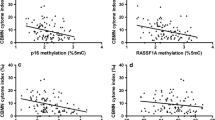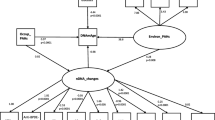Abstract
Global hypomethylation, gene-specific methylation, and genome instability are common events in tumorigenesis. To date, few studies have examined the aberrant DNA methylation patterns in coke oven workers, who are highly at risk of lung cancer by occupational exposure to polycyclic aromatic hydrocarbons (PAHs). We recruited 82 PAH-exposed workers and 62 unexposed controls, assessed exposure levels by urinary 1-hydroxypyrene, and measured genetic damages by comet assay, bleomycin sensitivity, and micronucleus assay. The PAHs in coke oven emissions (COE) were estimated based on toxic equivalency factors. We used bisulfite-PCR pyrosequencing to quantitate DNA methylation in long interspersed nuclear element-1 (LINE-1) and O6-methylguanine-DNA methyltransferase (MGMT). Further, the methylation alteration was also investigated in COE-treated human bronchial epithelial (16HBE) cells. We found there are higher levels of PAHs in COE. Among PAH-exposed workers, LINE-1 and MGMT methylation levels (with CpG site specificity) were significantly lowered. LINE-1, MGMT, and its hot CpG site-specific methylation were negatively correlated with urinary 1-hydroxypyrene levels (r = −0.329, p < 0.001; r = −0.164, p = 0.049 and r = −0.176, p = 0.034, respectively). In addition, LINE-1 methylation was inversely associated with comet tail moment and micronucleus frequency, and a significant increase of micronucleus in low MGMT methylation group. In vitro study revealed that treatment of COE in 16HBE cells resulted in higher production of BPDE-DNA adducts, LINE-1 hypomethylation, hypomethylation, and suppression of MGMT expression. These findings suggest hypomethylation of LINE-1 and MGMT promoter could be used as markers for PAHs exposure and merit further investigation.



Similar content being viewed by others
References
Bollati V, Baccarelli A, Hou L et al (2007) Changes in DNA methylation patterns in subjects exposed to low-dose benzene. Cancer Res 67(3):876–880. doi:10.1158/0008-5472.can-06-2995
Bowman RV, Wright CM, Davidson MR, Francis SM, Yang IA, Fong KM (2009) Epigenomic targets for the treatment of respiratory disease. Expert Opin Ther Targets 13(6):625–640. doi:10.1517/14728220902926119
Chanda S, Dasgupta UB, Guhamazumder D et al (2006) DNA hypermethylation of promoter of gene p53 and p16 in arsenic-exposed people with and without malignancy. Toxicol Sci 89(2):431–437. doi:10.1093/toxsci/kfj030
Cheng J, Leng S, Li H et al (2009) Suboptimal DNA repair capacity predisposes coke-oven workers to accumulate more chromosomal damages in peripheral lymphocytes. Cancer Epidemiol Biomarkers Prev 18(3):987–993
Costantino JP, Redmond CK, Bearden A (1995) Occupationally related cancer risk among coke oven workers: 30 years of follow-up. J Occup Environ Med 37(5):597–604
Cozens AL, Yezzi MJ, Kunzelmann K et al (1994) CFTR expression and chloride secretion in polarized immortal human bronchial epithelial cells. Am J Respir Cell Mol Biol 10(1):38–47
Crasta K, Ganem NJ, Dagher R et al (2012) DNA breaks and chromosome pulverization from errors in mitosis. Nature 482(7383):53–58. doi:10.1038/nature10802
Daskalos A, Nikolaidis G, Xinarianos G et al (2009) Hypomethylation of retrotransposable elements correlates with genomic instability in non-small cell lung cancer. Int J Cancer 124(1):81–87. doi:10.1002/ijc.23849
Esteller M, Hamilton SR, Burger PC, Baylin SB, Herman JG (1999) Inactivation of the DNA repair gene O6-methylguanine-DNA methyltransferase by promoter hypermethylation is a common event in primary human neoplasia. Cancer Res 59(4):793–797
Fenech M (2006) Cytokinesis-block micronucleus assay evolves into a “cytome” assay of chromosomal instability, mitotic dysfunction and cell death. Mutat Res 600(1–2):58–66
Furonaka O, Takeshima Y, Awaya H, Kushitani K, Kohno N, Inai K (2005) Aberrant methylation and loss of expression of O-methylguanine-DNA methyltransferase in pulmonary squamous cell carcinoma and adenocarcinoma. Pathol Int 55(6):303–309
Hogan M, Dattagupta N, Crothers DM (1979) Transmission of allosteric effects in DNA. Nature 278(5704):521–524
Hwang CS, Shemorry A, Varshavsky A (2009) Two proteolytic pathways regulate DNA repair by cotargeting the Mgt1 alkylguanine transferase. Proc Natl Acad Sci USA 106(7):2142–2147. doi:10.1073/pnas.0812316106
IARC (1983) Monographs on the evaluation of the carcinogenic risk of chemicals to humans. Polycyclic aromatic hydrocarbons. Part 1. Chemical, environmental and experimental data. France: IARC Vol. 32
Irahara N, Nosho K, Baba Y et al (2010) Precision of pyrosequencing assay to measure LINE-1 methylation in colon cancer, normal colonic mucosa, and peripheral blood cells. J Mol Diagn 12(2):177–183. doi:10.2353/jmoldx.2010.090106
Jones PA, Baylin SB (2002) The fundamental role of epigenetic events in cancer. Nat Rev Genet 3(6):415–428
Kaina B, Christmann M, Naumann S, Roos WP (2007) MGMT: key node in the battle against genotoxicity, carcinogenicity and apoptosis induced by alkylating agents. DNA Repair (Amst) 6(8):1079–1099
Lander ES, Linton LM, Birren B et al (2001) Initial sequencing and analysis of the human genome. Nature 409(6822):860–921. doi:10.1038/35057062
Leng S, Dai Y, Niu Y et al (2004) Effects of genetic polymorphisms of metabolic enzymes on cytokinesis-block micronucleus in peripheral blood lymphocyte among coke-oven workers. Cancer Epidemiol Biomarkers Prev 13(10):1631–1639
Moore LE, Pfeiffer RM, Poscablo C et al (2008) Genomic DNA hypomethylation as a biomarker for bladder cancer susceptibility in the spanish bladder cancer study: a case-control study. Lancet Oncol 9(4):359–366. doi:10.1016/s1470-2045(08)70038-x
Nelson HH, Marsit CJ, Kelsey KT (2011) Global methylation in exposure biology and translational medical science. Environ Health Perspect 119(11):1528–1533. doi:10.1289/ehp.1103423
Nisbet IC, LaGoy PK (1992) Toxic equivalency factors (TEFs) for polycyclic aromatic hydrocarbons (PAHs). Regul Toxicol Pharmacol 16(3):290–300
Pang Y, Li W, Ma R et al (2008) Development of human cell models for assessing the carcinogenic potential of chemicals. Toxicol Appl Pharmacol 232(3):478–486
Pavanello S, Bollati V, Pesatori AC et al (2009) Global and gene-specific promoter methylation changes are related to anti-B[a]PDE-DNA adduct levels and influence micronuclei levels in polycyclic aromatic hydrocarbon-exposed individuals. Int J Cancer 125(7):1692–1697
Pegg AE, Byers TL (1992) Repair of DNA containing O6-alkylguanine. Faseb J 6(6):2302–2310
Pogribny IP, Tryndyak VP, Boureiko A et al (2008) Mechanisms of peroxisome proliferator-induced DNA hypomethylation in rat liver. Mutat Res 644(1–2):17–23. doi:10.1016/j.mrfmmm.2008.06.009
Pulling LC, Divine KK, Klinge DM et al (2003) Promoter hypermethylation of the O6-methylguanine-DNA methyltransferase gene: more common in lung adenocarcinomas from never-smokers than smokers and associated with tumor progression. Cancer Res 63(16):4842–4848
Rodriguez J, Frigola J, Vendrell E et al (2006) Chromosomal instability correlates with genome-wide DNA demethylation in human primary colorectal cancers. Cancer Res 66(17):8462–9468. doi:10.1158/0008-5472.can-06-0293
Sadikovic B, Rodenhiser DI (2006) Benzopyrene exposure disrupts DNA methylation and growth dynamics in breast cancer cells. Toxicol Appl Pharmacol 216(3):458–468. doi:10.1016/j.taap.2006.06.012
Saito K, Kawakami K, Matsumoto I, Oda M, Watanabe G, Minamoto T (2010) Long interspersed nuclear element 1 hypomethylation is a marker of poor prognosis in stage IA non-small cell lung cancer. Clin Cancer Res 16(8):2418–2426. doi:10.1158/1078-0432.ccr-09-2819
Schmezer P, Rajaee-Behbahani N, Risch A et al (2001) Rapid screening assay for mutagen sensitivity and DNA repair capacity in human peripheral blood lymphocytes. Mutagenesis 16(1):25–30
Suter CM, Martin DI, Ward RL (2004) Hypomethylation of L1 retrotransposons in colorectal cancer and adjacent normal tissue. Int J Colorectal Dis 19(2):95–101. doi:10.1007/s00384-003-0539-3
Teneng I, Montoya-Durango DE, Quertermous JL, Lacy ME, Ramos KS (2011) Reactivation of L1 retrotransposon by benzo(a)pyrene involves complex genetic and epigenetic regulation. Epigenetics 6(3):355–367
Weisenberger DJ, Romano LJ (1999) Cytosine methylation in a CpG sequence leads to enhanced reactivity with Benzo[a]pyrene diol epoxide that correlates with a conformational change. The Journal of biological chemistry 274(34):23948–23955
Weisenberger DJ, Campan M, Long TI et al (2005) Analysis of repetitive element DNA methylation by MethyLight. Nucleic Acids Res 33(21):6823–6836. doi:10.1093/nar/gki987
Wilson VL, Jones PA (1983) Inhibition of DNA methylation by chemical carcinogens in vitro. Cell 32(1):239–246
Zhai Q, Duan H, Wang Y et al (2012) Genetic damage induced by organic extract of coke oven emissions on human bronchial epithelial cells. Toxicol in vitro : an international journal published in association with BIBRA 26(5):752–758. doi:10.1016/j.tiv.2012.04.001
Zhang FF, Cardarelli R, Carroll J et al (2011) Physical activity and global genomic DNA methylation in a cancer-free population. Epigenetics 6(3):293–299
Acknowledgments
This research was supported by the National Natural Science Foundation of China (NSFC 81172642, 81130050, 30700659, 81072284), a Key Program of Scientific Research of Public Welfare Project of the Ministry of Health of China (No.200902006), a Distinguished Young Scholar of NSFC (30925029), a National High-Tech Research and Development Program of China (2012AA062804), and partly financed by the State Key Laboratory of Environmental Chemistry and Ecotoxicology, Research Center for Eco-Environmental Sciences, Chinese Academy of Sciences (KF2010-02).
Conflict of interest
No potential conflicts of interest were disclosed.
Author information
Authors and Affiliations
Corresponding author
Additional information
Huawei Duan, Zhini He, and Junxiang Ma contributed equally to this work.
Electronic supplementary material
Below is the link to the electronic supplementary material.
Rights and permissions
About this article
Cite this article
Duan, H., He, Z., Ma, J. et al. Global and MGMT promoter hypomethylation independently associated with genomic instability of lymphocytes in subjects exposed to high-dose polycyclic aromatic hydrocarbon. Arch Toxicol 87, 2013–2022 (2013). https://doi.org/10.1007/s00204-013-1046-0
Received:
Accepted:
Published:
Issue Date:
DOI: https://doi.org/10.1007/s00204-013-1046-0




